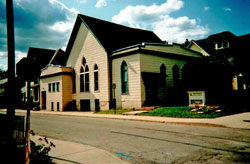 I was in the seventh grade when the news about the Jonestown tragedy was announced to a shocked world. Living in the state of Indiana, where Peoples Temple originated really sparked my fascination on the subject matter. It wasn’t until 2003 however, that I really pursued an interest in the subject. One day, I came across a newspaper article about a building for sale that was once home to Peoples Temple. The end of the article asked what a buyer would do with the former Peoples Temple. Well, my answer was, to open a museum.
I was in the seventh grade when the news about the Jonestown tragedy was announced to a shocked world. Living in the state of Indiana, where Peoples Temple originated really sparked my fascination on the subject matter. It wasn’t until 2003 however, that I really pursued an interest in the subject. One day, I came across a newspaper article about a building for sale that was once home to Peoples Temple. The end of the article asked what a buyer would do with the former Peoples Temple. Well, my answer was, to open a museum.
Perhaps a further word of introduction is in order here. I am a 43-year-old native of Indiana and have lived here all my life. I am a museums studies student at Indiana University at the Indianapolis campus. I previously earned a Bachelors degree in history from Indiana University, and some of my other academic interests include sociology, religious studies and anthropology. Combined with my ongoing quest for understanding Peoples Temple, this background gave me not only the inspiration for the project but – I hoped – the ability to see it through.
Nevertheless, the idea might be considered strange. I wasn’t sure if it would go over well in the community, and maybe a “museum” wasn’t exactly the correct term for my vision. It might be better to consider it a memorial center or a cultural center, with a museum feel to it. I think that the property is an important part of local and national history and should be recognized as such. I believe it befitting to honor the memory of the church members who perished at Jonestown. These people were dedicated caring individuals who worked together to achieve a common goal that they believed in. The goal of a society free of racism and social injustices was as worthy then as it is now. The cultural climate in the city of Indianapolis was extremely volatile during the period when Peoples Temple was located here, and their courage and fortitude deserves to be recognized.
Initially, as I expected, the reactions I got were negative. I lacked the financial means to achieve such an endeavor, and I knew I needed to attract investors to convince them – and by extension, the community – of its worth. Over the years I have consulted with numerous friends, business associates, and financial institutions, but all of my reasons for this project have fallen upon deaf ears. Ultimately I may have run into regional narrow-mindedness. Most people thought I was looking for a macabre freak show environment, but that of course was the exact opposite of what I hoped to achieve. My wishes were for a respectful institution aimed purely at educational and cultural aspects of the Peoples temple’s members and history.
After nearly five years of vacancy, the building is now home to the Restoration Baptist Church and while this complicates any visions I have of the People Temple memory/museum idea, it doesn’t end them, and I hope this article can breathe new life in my efforts.
I think it may be helpful if I talk with the new owners of the church and find out some more information about it. I am curious to learn what parts of the church are new and what parts if any are still in use that were in use when Peoples Temple was there. I was hoping to get some original building designs and learn a little more about the building’s history. Unfortunately, I have not been able to do that as of this writing.
(Chris Kelley can be reached at chrispk50@hotmail.com.)